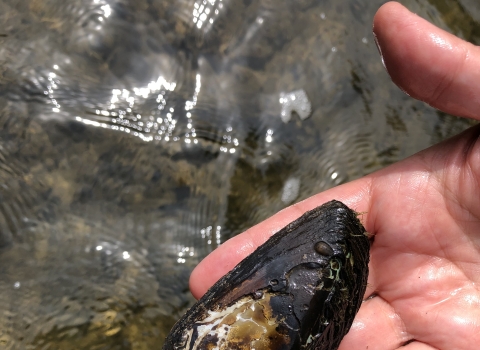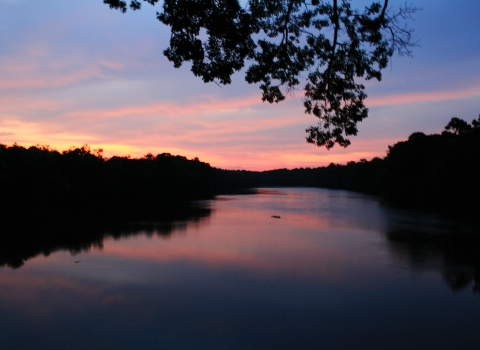Thanks to a concerted recovery effort spanning more than three decades, the U.S. Fish and Wildlife Service today proposed to remove the Aleutian Canada goose, one of the first animals protected under the Endangered Species Act, from the list of threatened and endangered species.
Populations of the goose, a small subspecies of Canada goose found only on a few of Alaskas remote, windswept islands and in areas of California and the Pacific Northwest, numbered only in the hundreds in the mid-1970s. Today, biologists estimate there are 32,000 birds, and the threat of extinction has been eliminated.
"This is a day for all Alaskans to celebrate. We have a lot to be proud of," said David B. Allen, U.S. Fish and Wildlife Service Regional Director for Alaska. "The recovery of the Aleutian Canada goose represents significant efforts by many individuals and groups. Chief among them are of course, the Alaska Department of Fish and Game, California landowners, the Pacific Flyway Management Council, and Japanese and Russian biologists."
"When you think about how few Aleutian Canada geese there were in 1973 and how many challenges they faced as a single species, it is truly rewarding when you look at their increasing strength today," said Marilyn Heiman, Special Assistant to Secretary of the Interior Bruce Babbitt. According to Heiman, the proposal to delist the goose represents a great victory and demonstrates that through conservation and recovery efforts, we can bring threatened and endangered species back to healthy levels.
"The Aleutian Canada goose joins a growing list of once-imperilled species that are on the road to recovery, including the bald eagle, the peregrine falcon and the Columbia white-tailed deer," said Heiman. "This is more proof that the Endangered Species Act works."
The Aleutian Canada goose, identifiable by a distinctive white neck band, nests on islands within the Alaska Maritime National Wildlife Refuge and winters in Oregon and California. Biologists trace the decline of the subspecies back as far as 1750 when fur farmers and trappers introduced foxes on more than 190 islands within the gooses nesting range in Alaska. The fox introductions hit their peak from 1915 to 1936 when fur demand was high.
The foxes decimated the birds, which had no natural defenses against land predators on the previously mammal-free islands. Biologists found no Aleutian Canada geese from 1938 until 1962, when a Service biologist discovered a remnant population on rugged, remote Buldir in the western Aleutian Islands.
The Service made the goose one of the first species or subspecies protected under the Endangered Species Act, passed in 1973. The first accurate count of the birds in 1975 revealed only 790 individuals. In the early 1980s, biologists found small numbers of breeding geese on two other islands.
For the past 35 years, biologists have worked to remove introduced foxes from former nesting islands, and reintroduce geese. Removing foxes benefitted many other bird species on these islands, including puffins, murres and auklets.
Besides removing foxes, the Service and state wildlife agencies closed wintering and migration areas to the hunting of Canada geese; banded birds on the breeding grounds to identify important wintering and migrations areas, and released families of wild geese caught on Buldir on other fox-free islands in the Aleutians. In California, the Service has worked extensively with local landowners in cooperative partnerships to protect and manage wintering habitat on private land through fee title acquisition, easements and voluntary programs. Important wintering and migration habitat in California and Oregon also has been acquired as national wildlife refuges.
As a direct result of these recovery activities, the population increased to 6,300 birds by 1990, enough for the Service to reclassify the subspecies from endangered to threatened. The recovery continued through the 1990s, with new populations firmly established on Agattu, Alaid and Nizki islands in the western Aleutians.
Although the overall population of Aleutian Canada geese is four times greater than the Services recovery goal, the goal of having 50 or more pairs of Aleutian Canada geese nesting in each of three geographic parts of its historic range (western Aleutians other than Buldir Island, central Aleutians, and the Semidi Islands) has yet to be fully met. The numbers of geese nesting in the central Aleutians and in the Semidi Islands are stable, but below the 50-pair objective. The Services proposal to delist the subspecies is based on the strength of the birds recovery in the western Aleutian Islands. The Service considered two other factors in proposing to delist the subspecies.
First, Russian and Japanese scientists are undertaking a program to reestablish Aleutian Canada geese in the Asian portion of their range. So far, Russian scientists have released 86 geese on Ekarma in the northern Kuril Islands. Japanese scientists have observed several of these birds on the wintering grounds in Japan.
Second, the Service, through the Migratory Bird Treaty Act, the Endangered Species Act and state wildlife agencies, have made conservation and management of winter and migration habitat in California and Oregon a high priority. The Service and the State of California also are carrying out plans to reduce competition between geese and humans on privately owned crop land and pastures.
If the Service decides to delist the Aleutian Canada goose, biologists will monitor the population for five years. The Service will pay particularly close attention to the small number of geese that nest in the Semidi Islands and winter on the north coast of Oregon.
Although the goose would no longer be protected under the provisions of the Endangered Species Act, the subspecies would still be protected under the Migratory Bird Treaty Act.
"The story of the Aleutian Canada goose is a success story for all Americans," said Allen. "The recovery of this unique bird shows how effective the Endangered Species Act can be through work with partners, and through innovative scientific techniques and on the ground cooperation."
Comments from all interested parties must be received within 90 days from Federal Register publication on August 3, 1999. The Service invites all interested parties to comment. Comments should be mailed to: USFWS Ecological Services/Anchorage, 605 West Fourth Avenue, Room G62, Anchorage, Alaska 99501. Copies of the proposal can be obtained by calling Greg Balogh at the U.S. Fish and Wildlife Service at (907) 271-2778.
The U.S. Fish and Wildlife Service is the principal federal agency responsible for conserving, protecting, and enhancing fish, wildlife and plants and their habitats for the continuing benefit of the American people. The Service manages the 93-million-acre National Wildlife Refuge System comprised of more than 500 national wildlife refuges, thousands of small wetlands, and other special management areas. It also operates 66 national fish hatcheries and 78 Ecological Services field stations. The agency enforces Federal wildlife laws, administers the Endangered Species Act, manages migratory bird populations, restores nationally significant fisheries, conserves and restores wildlife habitat such as wetlands, and helps foreign governments with their conservation efforts. It also oversees the Federal Aid program that distributes hundreds of millions of dollars in excise taxes on fishing and hunting equipment to state fish and wildlife agencies.
FWS
For additional information visit our web site at: http://www.r7.fws.gov/es/acg/acg.html or contact Connie M.J. Barclay at (907) 786-3695 or connie_barclay@fws.gov">


